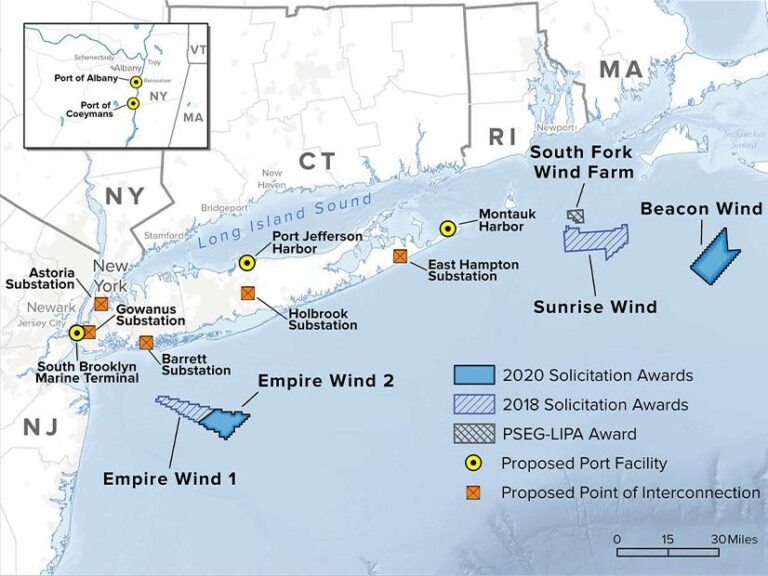New York has suspended its ambitious offshore wind transmission project, citing uncertainties at the federal level that have cast doubt on the plan’s feasibility.The decision comes amid ongoing regulatory and policy challenges that complicate the development of crucial infrastructure needed to support the state’s clean energy goals.This move highlights the broader tensions between state initiatives and federal oversight in advancing the United States’ renewable energy agenda.
New York Suspends Offshore Wind Transmission Project Citing Federal Policy Uncertainty
New York’s ambitious plan to develop an offshore wind transmission system has hit a major roadblock due to persistent uncertainties surrounding federal energy policies. Officials cited the lack of clear regulatory direction from Washington as the primary reason for pausing the project, which aimed to bolster the state’s renewable energy infrastructure and meet its aggressive clean energy goals by 2030. This suspension highlights the challenges faced by state-level initiatives when navigating complex federal approval processes and fluctuating administrative priorities.
Key factors influencing the suspension include:
- Ambiguities in federal permitting and grid interconnection rules
- Delays in securing necessary environmental clearances
- Concerns over funding mechanisms and cost recovery frameworks
- Uncertainty related to the Build America,Buy America Act compliance
| Aspect | Status | Impact |
|---|---|---|
| Federal Approvals | Pending | Project timeline delayed |
| Funding Guarantees | Uncertain | Financial risks increased |
| Environmental Review | In Progress | Potential for modifications |
Impact of Federal Regulatory Delays on Renewable Energy Development in the Northeast
Federal regulatory delays have significantly disrupted the momentum of renewable energy projects in the Northeast,with New York’s recent decision to halt its offshore wind transmission plan underscoring the consequences of prolonged uncertainty. The state’s ambitious targets for expanding offshore wind capacity face immediate setbacks as critical approvals remain stalled at the federal level. This regulatory gridlock not only postpones key infrastructure investments but also risks undermining investor confidence, threatening job creation and regional economic growth tied to the clean energy sector.
Key impacts observed include:
- Project timeline elongation: Delays in federal permits push back construction schedules, increasing overall costs.
- Funding challenges: Uncertainty deters private and public investment, jeopardizing the financial viability of several initiatives.
- Market instability: Intermittent policy signals create volatility in energy markets, complicating long-term planning for utilities and developers.
| Impact Area | Effect |
|---|---|
| Project Delays | +12 to 18 months |
| Investment Risks | High |
| Employment Forecast | Reduced by 15% |
| Energy Costs | Potential Increase |
Challenges Facing State-Federal Coordination in Advancing Offshore Wind Infrastructure
The recent suspension of New York’s offshore wind transmission plan underscores the complex web of challenges in state-federal coordination. Diverging regulatory frameworks at the federal and state levels have created significant gridlock, stalling infrastructure projects critical to achieving clean energy goals. States like New York push aggressively for offshore wind expansion to meet ambitious renewable targets, yet federal agencies tasked with permitting and environmental reviews frequently enough operate on longer timelines, leaving essential transmission projects in limbo.
Key Obstacles Include:
- Conflicting jurisdiction over leasing and permitting between federal bodies such as BOEM and state regulators
- Inconsistent environmental standards complicating the approval process
- Funding uncertainties due to shifting federal priorities and budget allocations
- Inter-agency dialog gaps delaying critical decision-making
| Challenge | Impact | Potential Solutions |
|---|---|---|
| Regulatory Overlap | Permitting Delays | Streamlined joint federal-state review |
| Funding Gaps | Project Stalls | Long-term bipartisan federal commitments |
| Data Sharing | Planning Inefficiencies | Integrated digital platforms for real-time updates |
Recommendations for Stabilizing Policy to Accelerate Offshore Wind Investment in New York
To ensure sustained growth in New York’s offshore wind sector, policy clarity and consistent regulatory frameworks are critical. Investors require long-term certainty to commit to multi-billion dollar projects, and fluctuating federal guidelines have introduced significant risks. Establishing a stable, transparent permitting process and federal-state coordination can significantly reduce project delays. Additionally, enhancing incentives such as tax credits and streamlined environmental reviews will attract private capital and technology innovation.
Key measures to accelerate offshore wind deployment include:
- Federal alignment: Harmonizing state and federal policies to avoid jurisdictional conflicts.
- Infrastructure investment: Prioritizing grid upgrades and dedicated transmission corridors.
- Stakeholder engagement: Expanding collaboration with coastal communities and industry leaders.
- Financial mechanisms: Introducing risk mitigation tools such as loan guarantees and public-private partnerships.
| Policy Area | Recommendation | Expected Impact |
|---|---|---|
| Permitting | Streamline federal approval timelines | Faster project initiation |
| Incentives | Extend tax credit programs | Boost investor confidence |
| Transmission | Develop dedicated offshore lines | Reduced grid congestion |
To Conclude
As New York pauses its offshore wind transmission project in response to ongoing federal regulatory uncertainties, the future of the state’s renewable energy ambitions faces renewed challenges. Stakeholders and industry watchers will be closely monitoring how federal agencies address these issues, as the outcome will significantly influence the pace and scope of offshore wind development not only in New York but across the United States.




